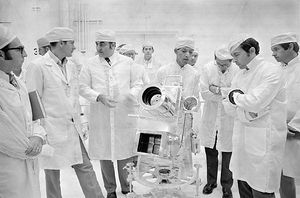George Carruthers: Difference between revisions
No edit summary |
No edit summary |
||
| (7 intermediate revisions by 3 users not shown) | |||
| Line 1: | Line 1: | ||
== George Carruthers | {{Biography | ||
|Image=LunarSurfaceUltravioletCamera.jpeg | |||
|Caption=George Carruthers, center, principal investigator for the Lunar Surface Ultraviolet Camera, discusses the instrument with Apollo 16 Commander John Young, right. Carruthers is employed by the Naval Research Lab in Washington, D.C. From left are Lunar Module Pilot Charles Duke and Rocco Petrone, Apollo Program Director. This photograph was taken during an Apollo lunar surface experiments review in the Manned Spacecraft Operations Building at the Kennedy Space Center. Date: 11/12/1971. Source: http://grin.hq.nasa.gov/ABSTRACTS/GPN-2000-001859.html | |||
|Birthdate=1939/10/01 | |||
|Birthplace=Cincinnati, OH, USA | |||
|Death date=2021/12/26 | |||
|Associated organizations=NASA | |||
|Fields of study=Aerospace | |||
|Awards=Black Engineer of the Year | |||
}} | |||
George Carruthers was born in Cincinnati, Ohio in 1939 and grew up in Chicago. He received his bachelors in aeronautical science (1961), masters in nuclear engineering (1962) and doctorate in aeronautical and space engineering (1964) from the University of Illinois. After school, Carruthers joined the Naval Research Laboratory in Washington where he worked on ultraviolet observations. | |||
Carruthers was the principal inventor of the Far Ultraviolet Camera/Spectrograph for the first moon-based observatory, which was used on the 1972 Apollo mission. Other NASA projects Carruthers participated in included the first detection of molecular hydrogen in space, an ultraviolet image of [[Geomagnetism and Edmond Halley (1656-1742)|Halley’s]] Comet, and an image of a Leonid shower meteor coming into Earth’s atmosphere. In 1982, Carruthers became head of NRL’s Ultraviolet Measurements Branch. | |||
Carruthers was named Black Engineer of the Year in 1987, and in 1997 he joined the Independent Scientific Review which advises the Hubble Space Telescope Project. | |||
[[Category:Transportation]] [[Category:Aerospace engineering]] [[Category:Nuclear and plasma sciences]] [[Category:Nuclear physics]] | |||
{{DEFAULTSORT:Carruthers}} | |||
Latest revision as of 12:32, 26 January 2021

- Birthdate
- 1939/10/01
- Birthplace
- Cincinnati, OH, USA
- Death date
- 2021/12/26
- Associated organizations
- NASA
- Fields of study
- Aerospace
- Awards
- Black Engineer of the Year
Biography
George Carruthers was born in Cincinnati, Ohio in 1939 and grew up in Chicago. He received his bachelors in aeronautical science (1961), masters in nuclear engineering (1962) and doctorate in aeronautical and space engineering (1964) from the University of Illinois. After school, Carruthers joined the Naval Research Laboratory in Washington where he worked on ultraviolet observations.
Carruthers was the principal inventor of the Far Ultraviolet Camera/Spectrograph for the first moon-based observatory, which was used on the 1972 Apollo mission. Other NASA projects Carruthers participated in included the first detection of molecular hydrogen in space, an ultraviolet image of Halley’s Comet, and an image of a Leonid shower meteor coming into Earth’s atmosphere. In 1982, Carruthers became head of NRL’s Ultraviolet Measurements Branch.
Carruthers was named Black Engineer of the Year in 1987, and in 1997 he joined the Independent Scientific Review which advises the Hubble Space Telescope Project.